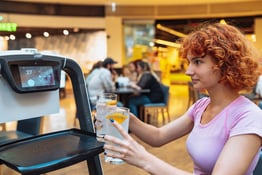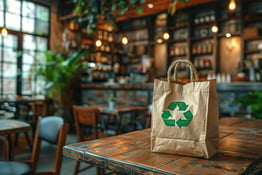After studying accounting in college, Frank Klein went on to work in the financial field. But the passion just wasn’t there. It wasn’t long until he started shifting his business expertise to the hospitality industry, helping a couple of friends open up restaurants, and then eventually launching several of his own across the San Francisco Bay area.
In 2005, Klein started FK Restaurants and Hospitality, a consulting company focused on efficiency and sustainability. That latter aspect – building eco-conscious restaurants – is what drives much of his work today, first sparked by a client held roughly 15 years ago, the National Park Service's concession areas.
“Of course there's a very big emphasis on sustainability there, so I started looking at alternative packaging, alternative foods, sourcing more locally, and trying to make the National Park Service concessions as sustainable as possible,” says Klein. “In the last couple decades, that’s filtered into everything – myself, my businesses, and my clients.”
Klein became a founding partner of the highly popular, fast-casual chain Asian Box in 2012. And from the start, components like compostable packaging and locally sourced ingredients were made a top priority. These days, Klein won’t take on consulting clients that aren’t committed to doing the same.
We sat down with Klein to learn more about his current sustainability initiatives and why he believes it's crucial that every operator pay close attention to their environmental footprint. Plus, he shares advice on how to do so.
I’d love to hear more about the main ways the concept of sustainability has directed your work.
Whether it’s trash, or toxicity to water or air, restaurants provide a lot of pollution and landfill. To make food service better for the earth, you have to start looking at alternatives. When we opened up Asian Box, we were the first fast-casual to do 100% landfill diversion rate, meaning that everything we gave to a customer was either compostable or recyclable. And that was very important for us.
In the kitchens, we were reusing boxes, having certain produce providers deliver in recyclable containers, and so we had less stuff going to the landfill and less trash in general. A lot of municipalities may say they recycle but that doesn't necessarily mean they do. The less trash you have, whether it's recyclable or compostable, the better off you are.
We also really focused on making sure that our packaging was made from post-consumer recyclable materials with eco-friendly inks, and then working with vendors that were partners with us in the mission of trying to be more sustainable. That goes into the food sourced, too. If you source food locally, there's less fossil fuels required, as opposed to trucking it from greater distances. That's just a plain and simple fact. So we were always looking for local vendors and ingredients, and also vendors that weren’t using excessive water techniques or chemicals.
As you mentioned, not all recycled material actually ends up getting recycled and a lot of compostable materials end up in the landfill. Do you have any advice on how to think about this or what operators can do?
Use less of everything, and then try to make sure you’re working with someone that can make [composting and recycling] possible. There are actually independent recyclers around the country that will pick up your stuff for free or for a small fee because they're going to get redemption when they take it to a recycling center.
But you have to watch and verify. Sometimes the recycling facility is at capacity. So where does that stuff go? It's not going to be 100% perfect. Nothing is, but you just want to be able to watch and make sure that you're contributing for good.
With margins being squeezed tighter and tighter, can you share any advice on how to balance the often higher cost of local products with the desire to stay as sustainable as possible?
I refute the premise that local vendors are more expensive. Maybe that was the case 10, five, or even three years ago. But nowadays when you look at local, it can be cost effective. The joke is now with gas prices, petroleum-based products are more expensive than compostable-based products.
But when you're looking at opening up a restaurant, you have to understand that you’re going to be damaging the earth, so it’s about budgeting so that you do that as little as possible. If certain packaging or local vendors are more expensive, what can you do to negotiate partnerships for the long term to keep those costs down?
It’s just like labor going up. Sustainability is a component of operations. To do less damage, you have to consider that as one of your main components of operations, along with labor, food, and then, sneaking up there with inflation, packaging. From day one, there are a lot of ways you can start being earth-friendly that can be baked into the cake of your overall P&L, and I think a lot of people unfortunately don't look at it that way.
How about in terms of balancing local ingredient costs?
Farmers do lower prices if you enter into longer-term contracts. At Asian Box, for example, we had year-long contracts with farmers for chicken. Most good fast-casuals do this. You guarantee, I'm going to buy XYZ of sustainably raised chicken, and then you get a specific price.
When you're negotiating with people, you never want to hurt anybody. You can't get into a long-term relationship with a vendor if you're grinding them too hard. It won't last. So communication is the number one thing.
I believe in menu threading, too. Do you really have to have five different types of potatoes on your menu, or can you get away with two? Do you really need to have three different types of meat vendors? Having precise, tight menus equals more profitable menus because you're dealing with less vendors, and you're using more of their specific product, which relates to better prices.
Finding the right packaging solution can be cumbersome. Where do you advise operators to start?
You have to look at both sides – where you're getting your packaging from and how your packaging is made. When we opened up Asian Box in Palo Alto 12 years ago, there was probably one or two eco-friendly packaging companies, and now there's probably around 20. They’re all available to talk to you and walk you through the different pricing structures. A lot of sustainable packaging companies have different layers of products that you can break into. I would say don't kill yourself initially. If you need to take baby steps to get to the most sustainable products, do it. It's extremely important. Your restaurant is damaging the earth every day. But it's also serving a purpose, which is the wonderful, communal nature that we're all in hospitality for.
What are some of the best ways to offset the additional costs you may absorb to make a more sustainable restaurant?
Just be more efficient. Have less waste in your kitchen. Make sure your portions are correct. Make sure spoilage is almost zero, theft is almost zero, and cost out your menu so you can put out a product that the market can bear.
Say you do a sustainable burrito with everything in sustainable packaging. Then you have the nitty gritty of getting down to the portion size and cost of that. You really have to decide, am I putting out a five or six ounce product. Am I putting it into a big or small box? Am I putting the side dish in a separate compostable container or placing it as a scoop next to the burrito?
Efficiency in operations and volume cures all ails. If you run a good business, do good sales, and do all of those efficiencies, you should be able to have an extremely sustainable restaurant, both in profitability and in eco-friendliness.
Are there any parts of your tech stack that you find most important for helping with some of these efficiencies?
I think the best things that are working, without naming names, are inventory software. It used to be the one thing they’d sell on POS that no one would use, but now people are using it. Menu formulation and pricing in tech is more important than ever. There are a couple people out there that are consolidating your invoices and explaining price variations that are extremely important, especially with supply chain issues. What you pay for a case of broccoli this week versus what you paid two weeks ago versus your usage – that helps you help thread your menu to be more sustainable and also more profitable.
How does your passion for sustainability currently shape your consulting business?
We don’t work with anyone that doesn’t have sustainability as a core ethos. If you’re not recycling in your kitchen, not putting things into proper bins, not using sustainable elements, and you’re openly using pesticide-laden products, that’s not a right fit for us.
From the start, we explain that there’s a potential cost of sustainability. Can your product be manipulated in such a way so your customer wants it at that price, and you get the return that you need? That paradigm is extremely important from day one. If you say you want to use sustainable beef versus regular beef, you better know the difference is $3 to $4 a pound, and on a four-ounce item, that’s going to be a dollar differential on your cost. We try to help clients determine their costs, as far as their menu, the packaging, and the whole thread. You're going to get materials in, manipulate those materials, and sell those materials, in some type of a package in fast-casual. All four of those steps need to be costed out, understood, and very specific.
You can't just open up and say everything's going to be sustainable and organic, and then you start to realize you have to charge $11 or $12 more than the $15 you really have to charge. So there’s that middle ground. Maybe you change some ingredients that you dreamed of and manipulate your product based on profitability you need to have on the back-end.
What small, sustainability-focused steps can all restaurant owners be taking now?
Evaluate your packaging, number one, and start trying to eliminate anything that's landfill. Get rid of bad plastics. Nobody should be using styrofoam these days, even if the city allows it. And start using post-consumer recycled materials in building and packaging.
Then start looking at your vendors, where products are made, and how they're processed. Then, figure out what prices you need to adjust. Any restaurateur should reach out to anyone they feel is doing best practices and ask them for referrals to sustainable vendors. It can open up great relationships and avenues to high-quality and earth-friendly products.
Where do you see sustainability trends in this industry headed in the future?
On the food side, plant-based advocates are saying that's more sustainable, and so that's definitely happening. I think that's a great thing. I'm a big meat eater, but I eat vegan three times a week.
Then, just healthier grown and processed meats. Even the big companies are learning very quickly that they’ll lose a market if they don't start processing things healthier.
As the technology becomes better to recycle and reuse, using recycled products is a very big thing in packaging right now. And I’m very proud of more cities and restaurants getting rid of plastic bags and styrofoams. So those three components are all big trends that are here to stay.





